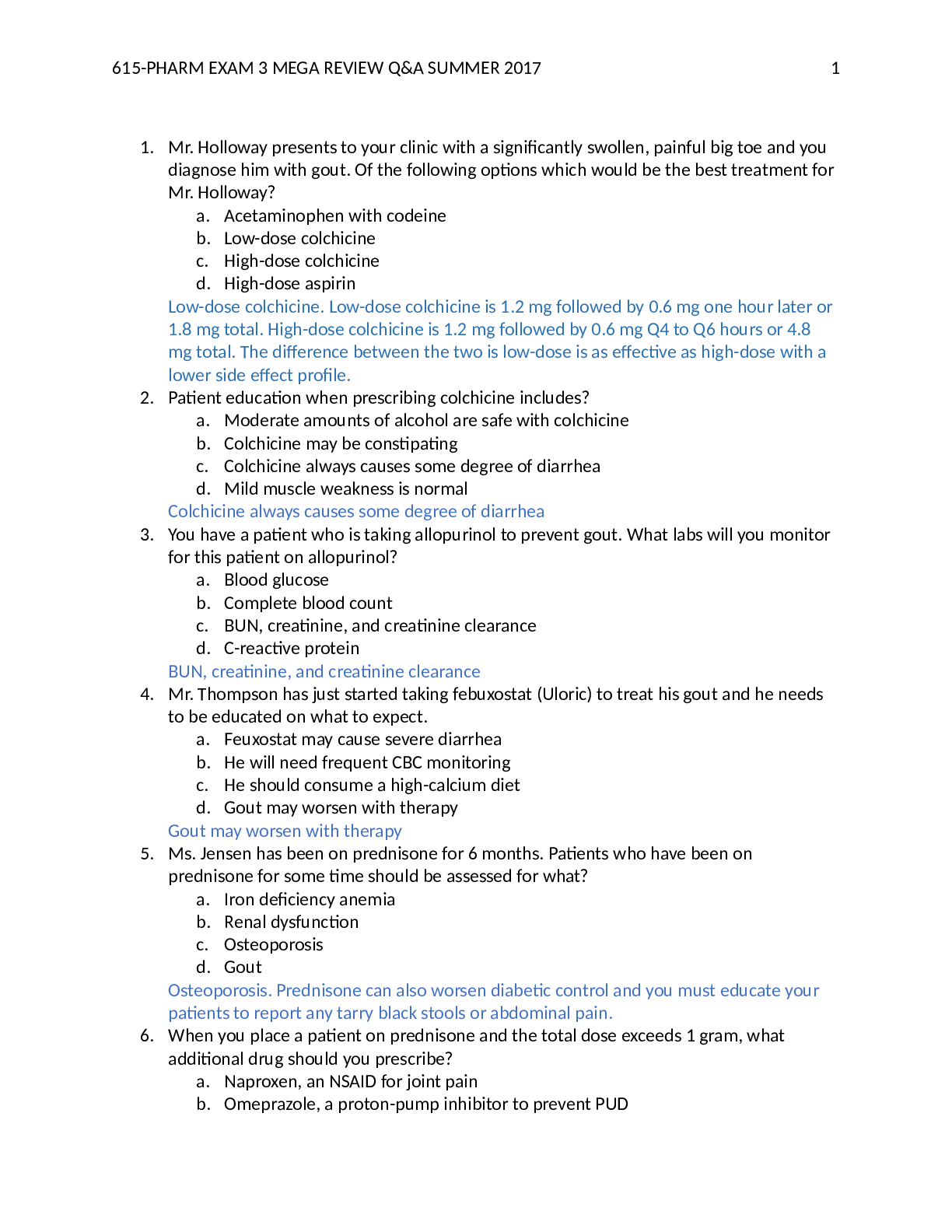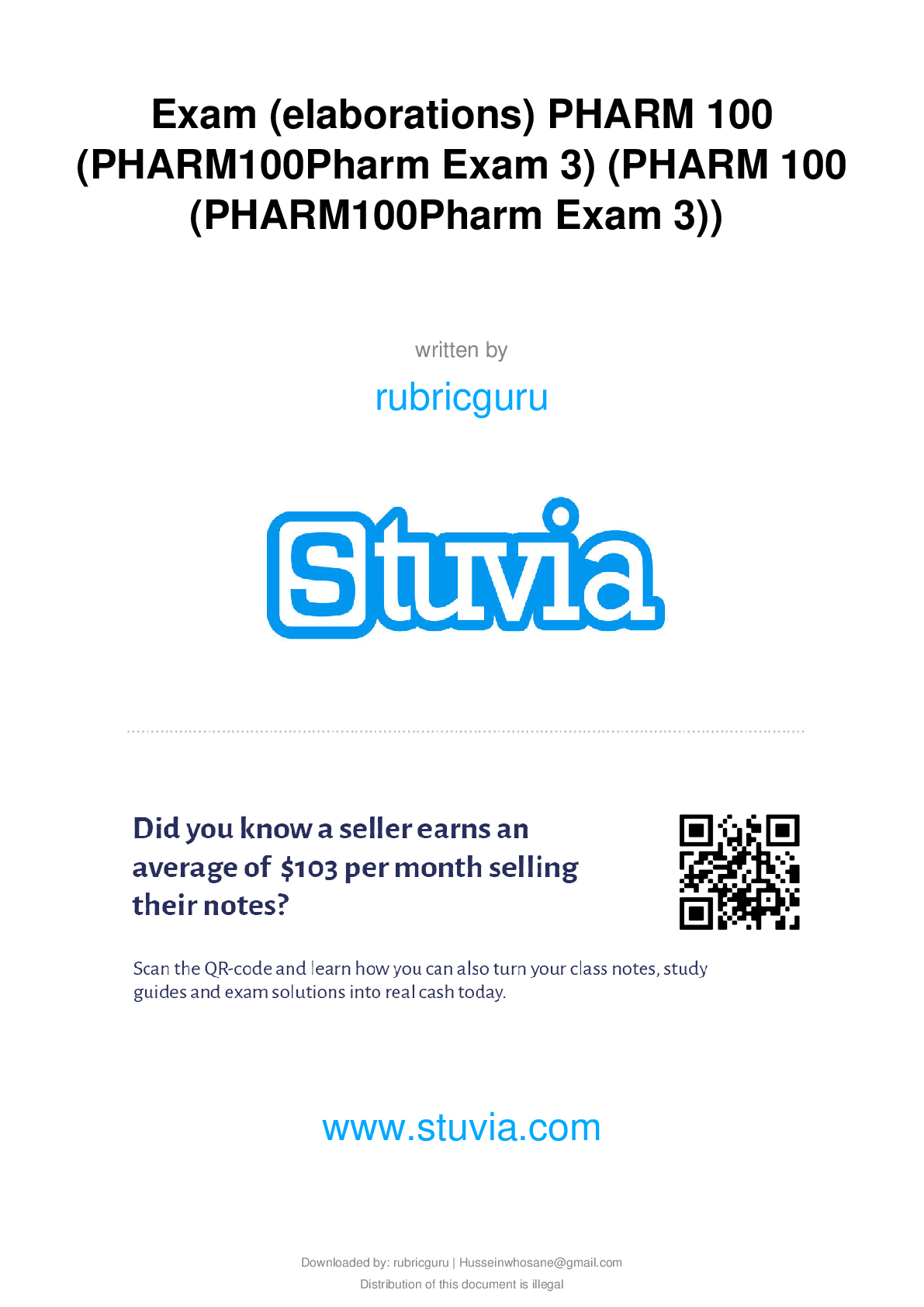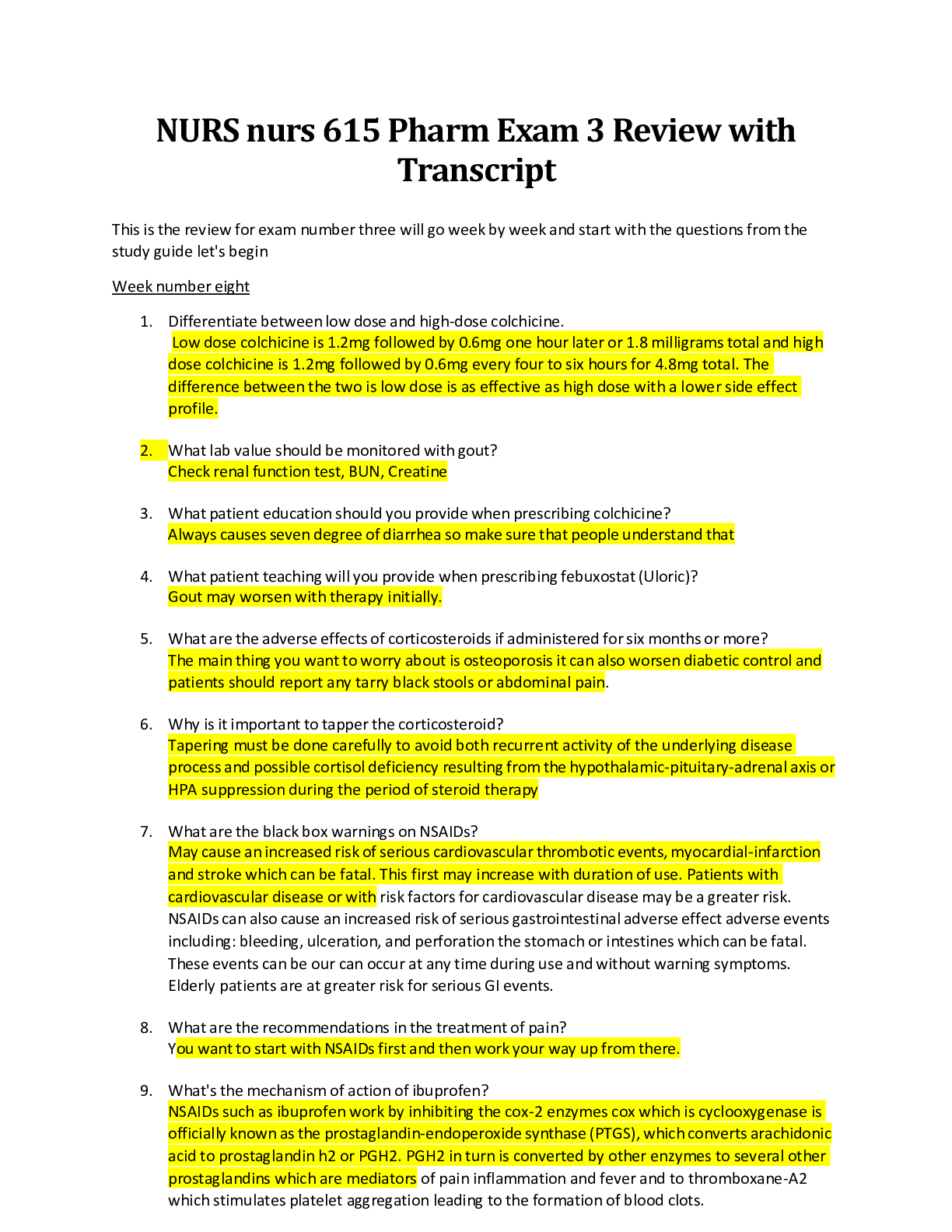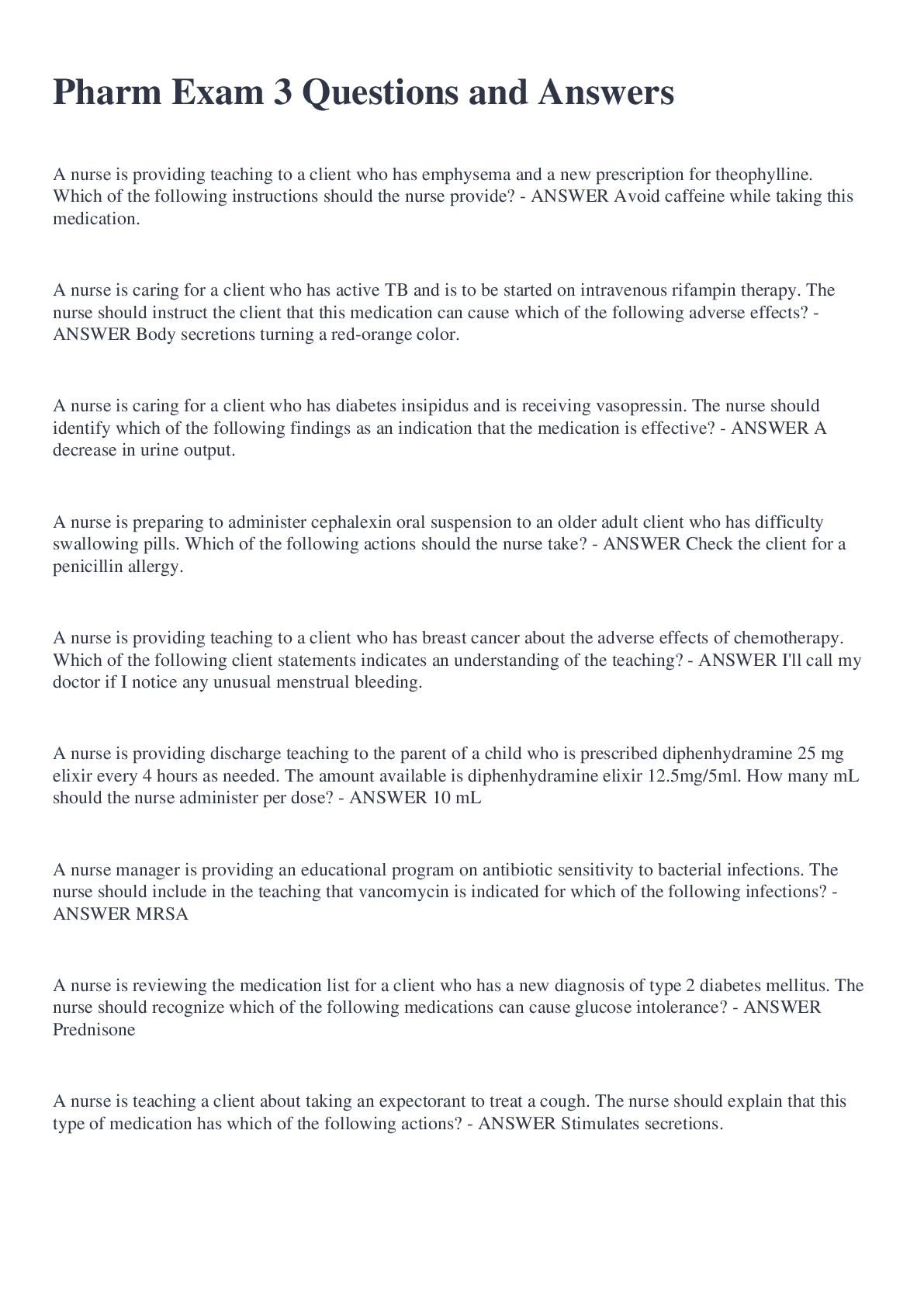Pharmacology > EXAM > PHARM 100 PHARM EXAM 3 (All)
PHARM 100 PHARM EXAM 3
Document Content and Description Below
PHARM 100 PHARM EXAM 3 Chapter 22 Antihypertensive Drugs 12% - 6 questions I. Adrenergic a. MOA: i. alpha1 adrenergic blockers: dilate arteries and veins 1. decreasing peripheral vascular resista... nce & blood pressure 2. increase urinary flow rates 3. decrease outflow obstruction ii. Beta blockers (lol):Beta1 receptor block 1. Reduce heart rate iii. Dual-action alpha1 and beta receptor blockers 1. Reduce heart rate 2. Vasodilation b. Adverse effects: i. Bradycardia with reflex tachycardia 1. Adding a Calcium blocker will help prevent ii. Hypotension, dry mouth, drowsiness, dizziness, depression, edema, sexual dysfunction iii. First dose syncope: hypotensive effect where pt loses consciousness even with first dose iv. Orthostatic (postural) hypotension c. Drug profiles: i. Alpha2-adrenergic receptor stimulators (agonists) – not first line drugs 1. Clonidine a. Also used for management of opioid withdrawal b. Don’t discontinue abruptly – rebound hypertension ii. Alpha1 blockers 1. Doxazosin a. Pt ed: may see extended-release capsule in stool i. Reassure that drug has been absorbed and is working iii. Dual action alpha1 & beta receptor blockers 1. Carvedilol a. Used in conjunction for treatment of mild-moderate heart failure II. ACE inhibitors a. Not prodrugs: must be metabolized (usually by liver) before its effective i. Except Captopril & Lisinopril 1. OK to give to pts with liver dysfunction b. MOA: i. Cardiovascular: reduction systemic vascular resistanceii. Renal: causes diuresis c. Indications: hypertension & heart failure i. Heart failure: 1. Cardioprotective Effect: stops ventricular remodeling a. Ventricular remodeling: progression of left ventricular hypertrophy (sometimes seen after an MI) d. Adverse Effects i. Dry, nonproductive cough ii. Hyperkalemia especially with potassium sparing diuretics 1. Assess serum potassium iii. Neutropenia 1. Assess lab Blood counts e. Drug Profiles: i. Captopril ii. Enalapril III. Angiotensin II Receptor Blockers (ARBs) (sartans) a. MOA: affect primarily vascular smooth muscle and adrenal gland b. Do NOT cause cough c. Indications: hypertension & heart failure d. Adverse effects: i. Chest pain, fatigue, hypoglycemia, diarrhea, UTI, anemia, weakness ii. Hyperkalemia is less common – however serum potassium monitoring is necessary e. Interactions: i. Can promote hyperkalemia when taken with potassium supplements f. Drug Profiles i. Losartan: use with caution in pts with renal/hepatic dysfunction IV. Calcium Channel Blockers a. MOA: cause smooth muscle relaxation, preventing contraction b. Indications: i. Will be us ned with beta blockers to prevent reflex tachycardia ii. Treatment of Reynaud’s disease, migraine headache V. Diuretics: a. First line antihypertensives b. lower blood pressure by decreasing plasma and fluid volumes VI. Vasodilators a. MOA: reduce systemic vascular resistance by peripheral vasodilation b. Drug Profiles: i. Hydralazine 1. Used with isosorbide dinitrate as adjunct for treatment of heart failure in African Americans2. Adverse effects: dizziness, headache, anxiety, tachycardia, edema, dyspnea, n/v/d, hepatitis, vitamin B6 deficiency, rash ii. Sodium nitroprusside 1. Used in intensive care for severe hypertensive emergencies 2. Adverse effects: bradycardia, decreased platelet aggregation, rash, hypothyroidism, hypotension 3. Cyanide ions are a by-product of nitroprusside a. Watch for cyanide and thiocyanate toxicity at high doses for a long timeChapter 23 Antianginal Drugs 12% - 6 questions I. Nitrates and Nitrites: a. Nitroglycerin i. MOA: dilate all blood vessels redistributing blood and O2 to previously ischemic heart tissue, reducing angina symptoms ii. Indications: stable, unstable, vasospastic angina iii. Contraindications: severe anemia, closed-angle glaucoma, hypotension, severe head injury iv. Adverse effects: 1. Oral: headache, reflex tachycardia 2. Sublingual: a. Tongue feels as though it is burning i. Pt education: 1. Normal effect showing drug is working 3. Topical/Transdermal: a. contact dermatitis i. Pt education: 1. Do not apply on same area (rotate sites) 2. Wash area to remove prior dose before applying new dose (prevents overdose) b. Drug tolerance i. Pt education: 1. Arrange nitrate-free period (usually 8 hours) to allow enzymatic pathways to replenish v. Pt Education: 1. Administration when actively experiencing chest pain a. Spray: i. 1-2 sprays sublingual every 5 mins ii. Max of 3 doses within 15 mins b. Sublingual i. 1 tab under tongue ii. If pain not relieved, call 911 iii. Can repeat dose up to 3 tablets wait 5 mins between administration II. Beta blockers (lol) a. MOA: slow heart rate b. Indications i. Exertional angina ii. Migraines, stage fright c. Contraindications i. Bronchial asthma, diabetes mellitus, peripheral vascular diseased. Adverse effects i. Mask hypoglycemia ii. Hypo and hyperglycemia e. Drug Profiles: i. Atenolol: decreases death after MI ii. Metoprolol: decreases death after MI 1. Controls reflex tachycardia for pt taking Isosorbide mononitrate III. Calcium channel Blockers a. MOA: dilate relaxes smooth muscles surrounding coronary arteries causing dilation and reduction of coronary artery spasms b. Contraindications: acute MI, hypotension c. Drug profiles: i. Diltiazem 1. Treat hypertension and angina 2. Pt ed: Nutrition a. increase dietary fiber b. avoid grapefruit juiceChapter 24 Heart failure Drugs 10% - 5 questions I. Pharm overview: a. Positive Inotropic: i. Increase the force of myocardial contraction b. Negative inotropic: i. Reduce the force of contraction c. Positive Chronotropic i. Increase heart rate d. Negative Chronotropic i. Decreases heart rate e. Positive Dromotropic: i. Accelerate conduction of heart (AV node) f. Negative Dromotropic: i. Decelerate conduction of heart (AV node) Because of the pathophysiology of Heart failure, drugs are used in combination to reduce the work exerted by the heart. This can be accomplished with combination of medications: ACE inhibitors, Beta blockers, diuretics, etc. In this outline, I’m going to focus mostly on the cardiac glycoside medication Digoxin. Mainly because this is a common drug being used for heart failure and because of the adverse effects, drug interactions, and monitoring required. II. Cardiac Glycosides a. MOA: i. Works also with Atrial Fibrillation (afib) ii. Powerful positive inotropic drug iii. Increases myocardial contractility iv. Reduces heart rate v. Doesn’t increase oxygen consumption b. Drug Profiles: i. Digoxin 1. Nursing Process a. Assessment: i. Normal Therapeutic Digoxin levels: 0.5 to 2 ng/mL ii. Digoxin Toxicity: Digoxin level > 2 ng/mL 1. Signs/symptoms: a. Bradycardia, headache, dizziness, confusion, nausea, visual disturbances 2. Pt at risk for toxicity a. Hypokalemia & hypomagnesemia b. Heart failure or renal failure iii. Herbal supplements: Ginseng, hawthorn, licorice, St. John’s Wortiv. Heart Rate: 1. Assess by taking apical pulse a. If HR is <60bpm or >100bpm, hold the drug and notify provider v. Nutrition 1. Do not give with high fiber foods because it alters absorption 2. Antidote: Digoxin immune Fab a. Digoxin levels will remain high for days/weeks after administration b. Know that toxicity reversal has been effective by a reduction of signs/symptomsChapter 25 Antidysrhythmic Drugs 6% - 3 questions I. Class I Drugs a. MOA: work by correcting abnormal cardiac electrophysiologic function b. Adverse Effects: i. n/v/d ii. dizziness, headache, blurred vision iii. can produce new dysrhythmias c. Interactions i. Warfarin + amiodarone = increased bleeding times ->Monitor INR ii. No grapefruit juice d. Drug Profiles i. Class Ia 1. Procainamide a. Used (but not often) for atrial and ventricular tachydysrhythmias 2. Quinidine a. Direct action: electrical activity of heart b. Indirect action: anticholinergic effect ii. Class Ib 1. Lidocaine a. Treats ventricular dysrhythmias b. Only administered IV (extensive first pass effect) c. Raises the ventricular fibrillation threshold: i. decreases the sensitivity of cardiac cell membrane to impulses ii. decreases the cell’s ability to depolarize (automaticity) iii. Class Ic 1. Flecaine a. Initially thought that it was no more effective than placebo b. Now finding that safe and effective for AFib c. Better tolerated than quinidine or procamide 2. Propafenone a. Treat life-threatening ventricular dysrhythmias & afib II. Class II: BETA Blockers (LOLs) a. MOA: block SNS b. Cardioprotective c. Drug Profiles: i. Atenolol: 1. Cardioselective 2. Adverse effects: a. Bradycardiab. Wheezing c. Chest pain ii. Metoprolol 1. Cardioselective beta blocker 2. Given after MI to reduce risk for sudden cardiac death III. Class III a. MOA: i. inhibit repolarization ii. prolong refractoriness and action potential duration b. Drug Profiles: i. Amiodarone 1. Drug of choice for ventricular dysrhythmias 2. Adverse effects: a. Lipophilic – fat loving i. Penetrate and concentrate in adipose tissue of any body organ b. Contains iodine i. Hypo or hyperthyroidism c. Corneal microdeposits i. Cause visual halos ii. Photophobia iii. Dry eyes d. Pulmonary toxicity i. Assess: progressive dyspnea and cough e. Pulmonary fibrosis f. Long half-life (many days) i. Adverse effects may take 2-3months after stopping medication to subside 3. Interactions a. Digoxin: increases dig levels b. Warfarin: increases INR 4. Administration: a. Initially assess cardiac rhythm after first dose IV. Class IV drugs a. MOA: Calcium channel blockers i. Diltiazem 1. Temporary control of rapid ventricular response in afib, flutter, and PSVT pts ii. Verapamil 1. Prevents and convers recurrent PSVT V. Unclassified Antidysrhythmic a. Adenosinei. Extremely short half life (less than 10 seconds) 1. It is to be given FAST and as an IV push 2. It will cause asystole for a period of a few secondsChapter 26 Coagulation Modifier Drugs 16% - 8 questions I. Anticoagulants a. MOA: prevents clot formation & clot expansion b. Adverse effects: i. Bleeding ii. Heparin induced thrombocytopenia (HIT): can be fatal 1. Type I: gradual reduction in platelets 2. Type II: acute decrease in platelets 3. Treatment: a. d/c Heparin b. Administer Argatroban c. Drug Profiles: i. Heparin 1. DVT treatment a. Given IV – High alert medication b. Monitor blood coaguability i. activated partial thromboplastin time (aPTT) 2. Antidote: Protamine sulfate ii. Warfarin (Coumadin) 1. DVT prevention a. Oral b. Monitor blood coaguability i. PT/INR 2. Antidote: Vitamin K 3. Pt ed: a. Avoid foods rich in Vitamin K (leafy green veggies: kale, spinach, collard greens) b. Avoid herbal supplements: i. Increase bleeding times: dong quai, garlic, ginkgo ii. Decrease bleeding times: St. John’s Wort iii. Dabigatran 1. Stroke prevention in pts with a-fib 2. Requires no coagulation monitoring iv. Enoxaparin 1. Low molecular weight heparin 2. Do not give in combo with heparin 3. Administered subcutaneous injection a. Comes in prefilled syringe with an air bubble. Do not express out the air bubble (ensures full dose is given) v. Fondaparinux 1. No antidote availablevi. Rivaroxaban 1. No blood monitoring required II. Antiplatelet Drugs a. MOA: interrupt the clotting cascade b. Adverse effects: Bleeding c. Drug Profiles i. Aspirin 1. Adverse effect: a. Reye’s syndrome i. Hepatic and CNS damage ii. Children & adolescents: high risk ii. Clopidogrel Bisulfate 1. Most widely used 2. Pt education: a. Don’t take with: reduces effectiveness i. Calcium channel blockers ii. Amiodarone iii. NSAIDs & aspirin iv. Proton pump inhibitors iii. Eptifibatide 1. Used in intensive care or for cardiac catheterization III. Thrombolytic drugs a. MOA: Break down thrombi in the blood vessels (clot busters) b. Indications: i. Acute MI ii. DVT iii. Pulmonary embolism iv. Stroke c. Drug Profiles: i. Alteplase 1. Very short half life 2. Opens clogged artery rapidly, but only for a short time a. Given with heparin to prevent re-blockage of the affected blood vessel 3. Used for ischemic stroke 4. Pt ed: a. Avoid bleeding/bruising b. No IM injections while on this medication IV. Antifibrinolytic Drugs a. Actually promote clot formation b. Indications: i. Stops bleeding/oozing from surgical sitesii. Reduces blood loss and bleeding time in postop pts c. Drug Profiles: i. Amniocaproic acid 1. Prevents and controls excessive bleeding from surgery ii. Desmopressin 1. Increases platelet aggregation and clot formation 2. Used to stop bleedingChapter 27 Antilipemic Drugs 8% - 4 questions Antilipemic drugs are used to lower high levels of lipids (triglycerides & cholesterol) in the blood. As cholesterol levels rise in the blood, lipids and lipoproteins begin to form atherosclerotic plaque, which leads to CHD (coronary heart disease). This plaque is formed in the blood vessels that supply the heart with oxygen and nutrients. As the plaque forms the size of the vessels will decrease in size and will reduce the amount of oxygen and nutrients to the heart. Antilipemics work to lower lipids in the blood. I. HMG-COA reductase inhibitors – Drug names end in -STATIN a. General Information: i. Most potent antilipemic drug available ii. MOA: Inhibits enzymes that produce cholesterol iii. Recommended as first-line drug therapy 1. First-line means: first drug to be tried for a patient b. Contraindications i. Allergic to it (duh) ii. Pregnant women iii. Liver disease/high liver blood levels c. Adverse Effects: i. CNS: HA, dizziness, blurred vision, fatigue, insomnia ii. GI: Constipation, diarrhea, nausea iii. Other: myalgias (muscle pain), skin rash iv. RHABDOMYOLYSIS: is an adverse effect where the body begins to breakdown muscle proteins. This can lead to acute renal failure (ARF) and death. 1. Risks a. It is dose dependent: meaning the higher the statin dose, the higher the risk of developing rhabdomyolysis b. Taking it with: cyclosporine, gemfibrozil, erythromycin c. Age >65 y/o, hypothyroidism, renal insufficiency 2. When recognized early it is usually reversible by stopping the medication. 3. Signs/Symptoms: a. Muscle soreness/pain b. Changes in urine color d. Interactions: 1. No Grapefruit juice 2. Medications that increase risk of rhabdomyolysis: see pg 441 e. Drug Profiles: Atorvastatin & Simvastatin i. Atorvastatin1. Most commonly used drug 2. Lowers LDL & raises HDL 3. Take with evening meal or at bedtime. Bedtime dosing provides peak drug levels in a time frame that correlates better with natural diurnal (daytime) rhythm of cholesterol production in the body. ii. Simvastatin 1. One of the first –statins 2. First time dosing should be limited to 80mg/day 3. Lots of drug interactions: -azoles, -mycins, HIV protease inhibitors, cyclosporine, femfibrozil . See pg 442 4. Nursing Process a. Implementation i. Dosage prescription restriction: 80mg ii. Start pts on low mg dose II. Bile Acid Sequestrants a. General Information i. MOA: binds bile and prevents resorption of bile acids from the small intestines ii. Can be used alone or as an adjunct drug iii. Common BAS: Colestipol, Cholestyramine, Colesevelam b. Contraindications: i. Biliary or bowel obstruction ii. Phenylketonuria (PKU) c. Adverse Effects: i. GI: Constipation, nausea, belching, bloating ii. Other: HA, tinnitus, burnt odor of urine iii. Colesevelam: this drug has less GI AEs and drug interactions iv. Patient Education: 1. Manage GI effects 2. Take meds with meals d. Interactions i. Other drugs must be taken 1 hour before or 4-6 hours after * e. General Nursing Process: i. Assessment: 1. No PKU 2. Lots of drug interactions ii. Implementation 1. Mix powder with food or fluids (at least 4-6 ounces) 2. Dilute powder and dilute any undissolved portion with additional fluid 3. Dissolve powder for at least 1 full minute 4. Take 1 hour before or 4-6 hours after oral medication or meals f. Drug Profiles: i. Cholestyramine1. Has a constipating effect 2. Do NOT use in pts with: a. Complete biliary obstruction b. PKU 3. Available as a dry powder: a. choking risk if not diluted before administration 4. Nursing Process a. Assessment: i. Monthly lab testing: phenylalaline levels ii. Dietary restrictions because of the aspartame contained in the medication b. Implementation: i. Take just before meals or with meals ii. Never give to pts with PKU ii. Colestipol 1. Nursing Process Implementation: a. Causes constipation i. TEACH: eat high fiber ii. TEACH: increase fluid intake III. Niacins a. General Information: i. B3 vitamin ii. inexpensive iii. May be given as adjunct with other antilipemics iv. Not recommended as first-line drug b. MOA: i. Unknown but favorable lipid-lowering effects ii. Vasodilator of cutaneous vessels at high doses iii. Releases histamines 1. Increases gastric motility & acid secretion iv. May stimulate fibrinolytic system to break down fibrin clots c. Indications: i. Lowers lipid levels, increases HDL ii. Treatment of hyperlipidemia iii. Effects begin to be noticed after 1 – 4 days of therapy iv. Maximum effects after 3 – 5 weeks of continuous therapy d. Contraindications i. Liver disease ii. Peptic ulcer, active bleeding, gout e. Adverse Effects i. Integumentary1. Cutaneous Flushing a. Pt education: take small doses of aspirin or NSAID 30mins before Niacin to minimize 2. Pruritus (itching) 3. GI: Abdominal discomfort ii. Other: blurred vision, glucose intolerance, hepatotoxicity f. Interactions: i. Minimal. Except when taken with a -statin which can increase myopathy g. Drug Profile: i. Niacin 1. Start with a small daily dose with or after meals to minimize adverse effects 2. Not for pts with liver disease IV. Fibric Acid Derivatives a. MOA: i. Inhibit release fatty acid from adipose tissue ii. Inhibit the synthesis of triglycerides in the liver iii. Increase secretion cholesterol into bile iv. Change blood coagulation 1. Decrease platelet adhesiveness 2. Increase plasma fibrinolysis b. Indications i. Lower LDL & Raise HDL ii. Not recommended as first-line drug c. Contraindications i. Severe liver or kidney disease ii. Cirrhosis iii. Gallbladder disease d. Adverse Effects i. GI: Nausea, vomiting, diarrhea, gallstones ii. GU: Impotence, decreased urine output, hematuria iii. Other: Drowsiness, dizziness, rash, pruritus, vertigo iv. Rhabdomyolysis when given with a statinChapter 28 Diuretic Drugs 16% - 8 questions I. Carbonic Anhydrase Inhibitors (Potassium wasting) a. MOA: inhibits activity of carbonic anhydrase enzymes b. Indications: i. Long-term management of Open-angle glaucoma ii. Edema iii. High-altitude sickness c. Contraindications i. Hyponatremia, Hypokalemia ii. Severe renal or hepatic dysfunction iii. Adrenal gland insufficiency, Cirrhosis d. Adverse effects i. Metabolic abnormalities: acidosis, hypokalemia ii. Drowsiness, anorexia, paresthesias, hematuria, urticarial, photosensitivity, melena (blood in stool) e. Interactions: i. Hypokalemia with corticosteriods ii. Increase in digoxin toxicity f. Drug Profile: i. Acetazolamide 1. Do NOT use: a. Significant liver or kidney dysfunction b. Low serum potassium or sodium levels c. Acidosis d. Adrenal gland failure II. Loop Diuretics(Potassium wasting) a. MOA: dilation of blood vessels of kidneys, lungs and body b. Major Drug effects: i. Reduces blood pressure ii. Reduces pulmonary vascular resistance iii. Reduces systemic vascular resistance c. Indications i. Edema associated with heart failure and hepatic or renal disease ii. Control hypertension iii. Renal excretion of calcium for hypercalcemia d. Contraindications: i. Hypokalemia e. Adverse effects i. CNS: dizziness, headache, tinnitus, blurred vision ii. GI: N/V/D = dehydration iii. Cardiac arrhythmias iv. Hypokalemia f. Toxicity: electrolyte and fluid replacement g. Interactions: See table 28-3 p 455h. Drug Profile i. Furosemide 1. Indications: a. Pulmonary edema b. Edema: Heart failure, liver disease, nephrotic syndrome, ascites c. Hypertension caused by heart failure i. Nursing Process: i. Assessment: 1. Watch for interactions with neurotoxic or ototoxic medications 2. Allergy to sulfa 3. Skin assessment for exfoliative dermatitis 4. Hypokalemia ii. Evaluation: 1. Weight loss 2. Decreased Oxygen supplementation 3. Reduced edema 4. Increased output III. Osmotic Diuretics: MANNITOL(Potassium wasting) i. MOA: 1. Increases osmotic pressure, pulling in fluid (water) from surrounding tissues. 2. Rapid diuresis by Inhibiting tubular resorption of water and solutes ii. Indications 1. Reduces cellular edema 2. Reduces intracranial pressure 3. Increases urine production 4. Loss of electrolytes, especially sodium, is small a. Therefore it is not effective for peripheral edema iii. Evaluation 1. Reduction of cellular edema 2. Reduced intracranial pressure IV. Potassium-Sparing Diuretics: Spironolactone & Triamterene i. MOA: Interfere with sodium/potassium exchange by competitively binding to aldosterone receptors and blocking resorption of sodium and water ii. Indications 1. Spironolactone and Triamterene a. Hyperaldosteronism b. Hypertension c. Reverse potassium loss caused by potassium wasting diuretics 2. Spironolactone a. Cardioprotective iii. Contraindications 1. Hyperkalemia 2. Severe renal failure 3. Anuria4. Triamterene: severe hepatic failure iv. Adverse effects 1. General a. CNS: dizziness, headache b. GI: cramps, n/v/d c. Other: urinary frequency, weakness, d. Hyperkalemia 2. Spironolactone: a. Gynecomastia, amenorrhea, irregular menses, postmenopausal bleeding 3. Triamterene (rare): a. Reduce folic acid levels, kidney stones, urinary casts, megaloblastic anemia v. Interactions: 1. ACE inhibitors= hyperkalemia 2. Lithium = lithium toxicity 3. NSAIDs = decreased blood flow to kidneys > decreased diuretic response vi. Drug Profiles: 1. Spironolactone: a. Cardioprotective b. Can be used alone or in combination i. Potassium wasters to increase serum potassium levels 2. Triamterene a. No antihypertensive effect b. Can be used in combination V. Thiazides i. MOA: inhibit resorption of sodium, potassium, chloride ii. Indications: 1. Edema 2. Hypertension 3. Idiopathic hypercalciuria, diabetes insipidus 4. Management of heart failure and hepatic cirrhosis iii. Contraindications 1. Hepatic coma 2. Anuria 3. Severe renal failure iv. Adverse effects: See Table 28-5 pg 458 v. Interactions 1. Corticosteroids, diazoxide, digitalis, oral hypoglycemic vi. Drug Profiles 1. Inexpensive diuretic 2. Used in combination 3. Ceiling effect: dosages exceeding 50mg/day are not more effective . VI. Nursing Processa. Assessment i. Hypokalemia: 1. Potassium wasting medications (all but spironolactone & triamterene): a. Serum potassium labs b. Signs/symptoms: i. Anorexia ii. Nausea iii. Lethargy iv. Muscle weakness v. Mental confusion vi. hypotension ii. Hyperkalemia 1. Potassium Sparing medications (spironolactone & triamterene): a. Serum potassium labs b. Signs/Symptoms i. Nausea ii. Vomiting iii. Palpitations iv. FatigueChapter 29 Fluids and Electrolytes 14% - 7 questions I. Crystalloids: Sodium Chloride (0.9% Normal Saline) a. Given IV b. MOA: Maintain osmotic gradient between extravascular and intravascular compartments i. Expand the plasma volume c. Indications: i. Replace body fluids ii. Manage specific fluid and electrolyte imbalances d. Adverse effects: i. EDEMA e. Drug Profile: i. Sodium Chloride 1. correct hyponatremia 2. Infuse with Packed Red Blood Cells ii. Nursing Process: Assessment 1. EDEMA Isotonic solutions: Sodium Chloride (0.9% Normal Saline) Hypotonic solutions: 0.45% Normal Saline (NS), 0.25% NS Hypertonic solutions: 3% NS, 5% NS II. Colloids: a. MOA: plasma expander: pull fluid into blood vessels b. Indications: shock and burns c. Contraindications: hypervolemia d. Adverse effects: i. Impaired coagulation ii. Anaphylaxis, renal failure e. Drug profiles: i. Albumin 1. Nursing process: Assessment: a. Intake and output III. Blood products: a. With any blood products it is important to ensure that the pt receives the correct, matched blood product whether it is to ABO, or Rh or both. b. Assessment: during infusion must monitor vitals due to the possibility of anaphylactic reaction c. STOP transfusion immediately if the pt shows signs of reaction: tachycardia, hypertension, hypotension, fever, tachypnea IV. Potassium: a. See Ch 28 for signs/symptoms of hypo/hyperkalemiab. Treatment: i. Hypokalemia 1. Eat potassium rich foods (dark, green leafy veggies) 2. Potassium supplement a. Pt Education: Take medication whole, may excrete whole (that’s ok) ii. Hyperkalemia 1. Dialysis 2. IV dextrose and insulin 3. Polystyrene sodium sulfonate (see pg 472)Chapter 54 Anemia Drugs 6% - 3 questions I. Erythropoiesis-Stimulating Drugs a. Epoetin Alfa i. Promotes production of RBCs ii. Indications 1. Anemia associated with: a. End-stage renal disease b. Chemotherapy iii. Nursing Process: Assessment 1. Hemaglobin levels II. Iron a. Iron supplements i. Pt teaching 1. Causes constipation: increase fluid intake, high fiber foods 2. Take with Vitamin C to help absorption 3. Avoid antacids and calcium – inhibits absorption III. Folic Acid a. Effective for anemias caused by folic acid deficiency b. Important in preventing birth defects [Show More]
Last updated: 2 years ago
Preview 1 out of 24 pages
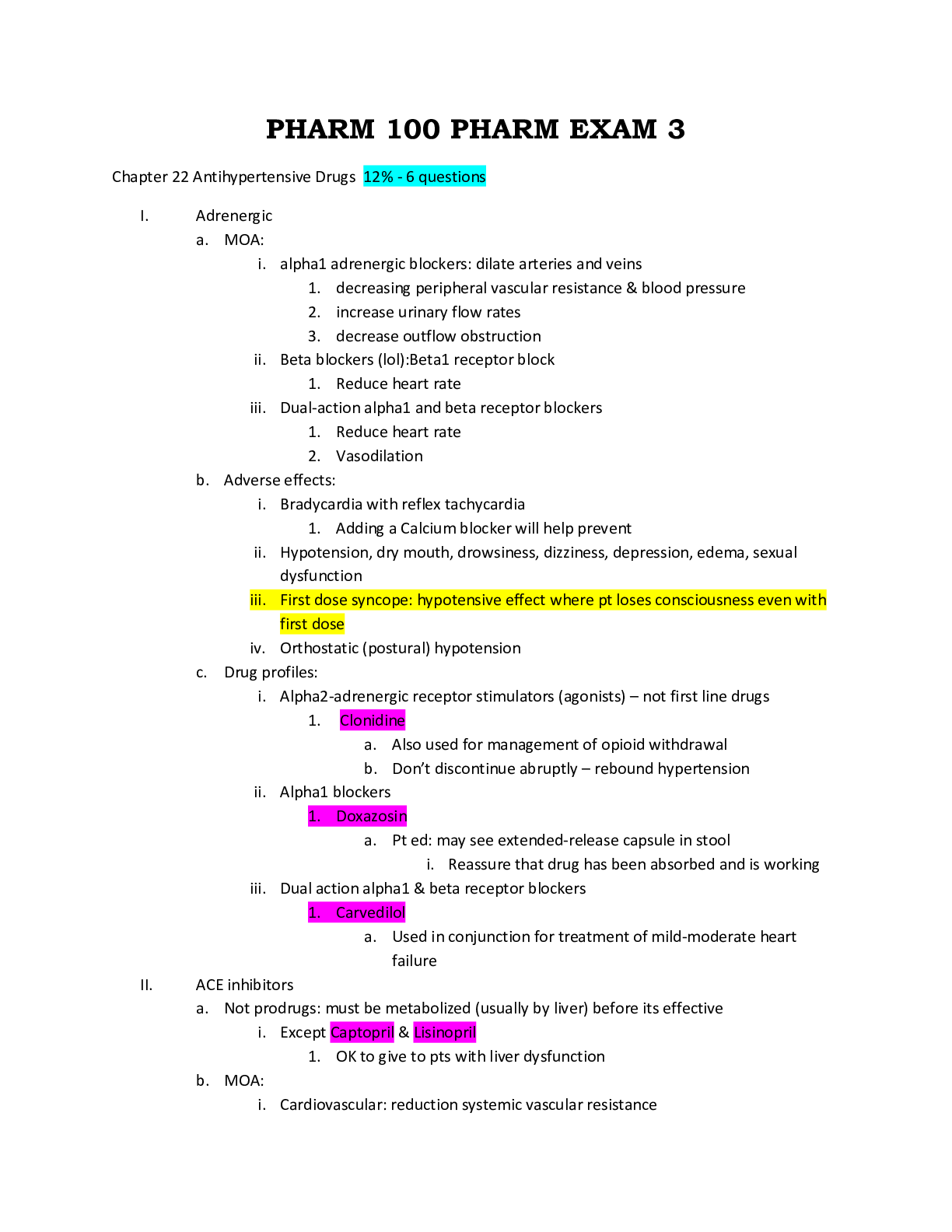
Buy this document to get the full access instantly
Instant Download Access after purchase
Buy NowInstant download
We Accept:

Reviews( 0 )
$10.00
Can't find what you want? Try our AI powered Search
Document information
Connected school, study & course
About the document
Uploaded On
Feb 11, 2021
Number of pages
24
Written in
Additional information
This document has been written for:
Uploaded
Feb 11, 2021
Downloads
0
Views
104














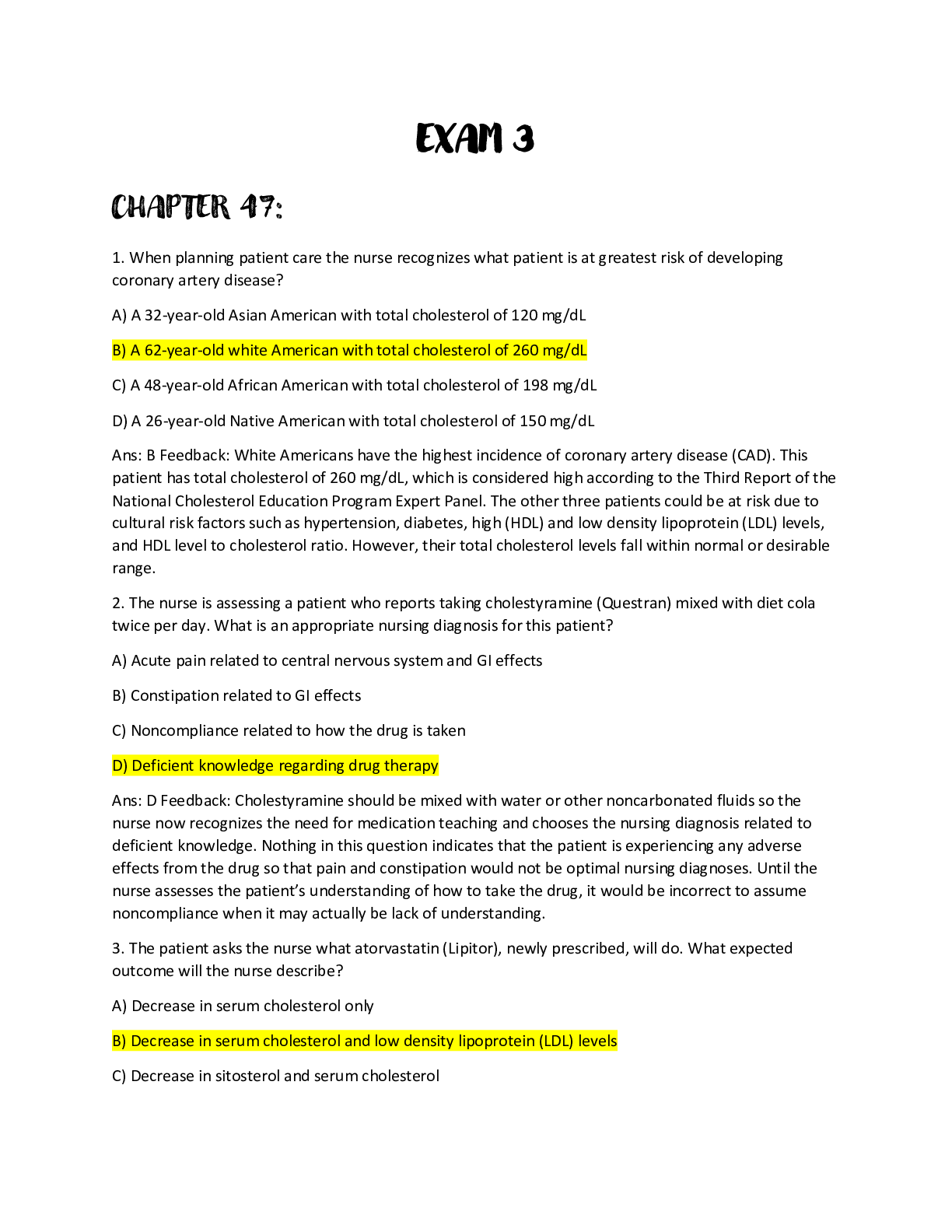
.png)
